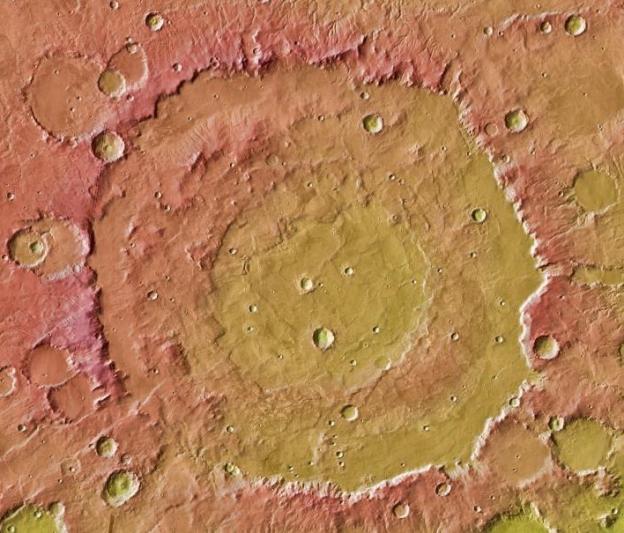Water on Mars May Have Been Triggered by Meteorite Impacts

Cosmic impacts on young Mars may have triggered deluges, potentially explaining why the Red Planet was once covered in water, a new study finds.
Although Mars is now cold and dry, scientists have for decades found evidence suggesting that the planet's surface was once covered with rivers, streams, ponds, lakes, and perhaps even seas and oceans. Since there is life virtually everywhere on Earth where there is water, this history of water on the Red Planet raises the possibility that Mars was once home to life and might host it still.
However, despite the evidence for Red Planet water, scientists haven't been able to figure out how Mars could have possessed this water during its early days. During the Red Planet's youth, the sun was cooler than it is now, and previous climate models suggested that Mars may have lacked enough greenhouse gases to trap enough heat to generate significant amounts of rainfall.
Related: Curiosity Rover Finds Ancient 'Building Blocks for Life' on Mars
New, not-yet-peer-reviewed research analyzes one potential answer to this mystery: that cosmic impacts heated Mars by generating enormous amounts of molten or vaporized rock and steam. That, the paper said, would help explain the signs of a warmer, wetter past Mars. To explore this possibility, scientists analyzed the environmental effects of cosmic impacts on computer models of the climate and geology of Mars.
"Using sophisticated three-dimensional global climate-model simulations similar to the ones used, for example, to simulate global warming on Earth, we were able to simulate for the first time in three dimensions the climate change induced by the very large impacts that hit Mars about 4 billion years ago," lead study author Martin Turbet, a planetary scientist and climatologist at the Sorbonne University in France, told Space.com.
The researchers focused on impacts from the largest rocks to ever hit Mars, ones more than 60 miles (100 kilometers) across. These are big enough to explain the largest craters seen on the Red Planet, basins more than 370 miles (600 km) wide.
Get the Space.com Newsletter
Breaking space news, the latest updates on rocket launches, skywatching events and more!
The scientists found that one of those impacts would make the atmosphere so hot that, for about half a Martian year, water would be unable to last on the Martian surface. After that, constant rain would fall for about a dozen Martian years. During this time, the water that was initially vaporized by the collision would return as deluges flooding the Red Planet, with an average of about 8.5 feet (2.6 meters) of water covering Mars per Earth year. (One Martian year is equal to about 1.88 Earth years.)
After these rains, Mars would quickly cool, with all its surface water freezing solid in 1,000 to 100,000 years. Over the course of another 10,000 to 1 million years, solar radiation would turn surface ice directly into water vapor, permitting water to migrate to and freeze at the Martian poles and other cold parts of the Red Planet.
The researchers calculated that an especially big impact — say, of a rock about 180 miles (300 km) wide, leaving a crater about 930 miles (1,500 km) in diameter — would, in addition to all these global consequences, create a local hot spot on Mars that could survive for tens of millions of years. Although, for most of its existence, this hot spot would not be warm enough to melt water on the Martian surface, it could help keep water liquid underground and at the bottom of any overlying ice deposits.
But the new findings don't explain some of the most notable water-created features on Mars: major valley networks south of the equator. Impact-related storms, however, likely peaked near the Martian equator. Previous research has also suggested that valley networks and the largest basins on Mars appear to have formed at different periods in the planet's history.
These findings also suggest that these deluges may have caused the crater erosion that scientists have identified in images of the Martian surface gathered by missions such as Mars Global Surveyor, Mars Express and Mars Reconnaissance Orbiter, Turbet said. In addition, the cosmic-impact-triggered deluges may have led to the formation of ancient clays on the Red Planet, consistent with the suspected ages of these materials, he noted.
The research is described in a paper posted to the pre-print site arXiv.org and submitted to, but not yet accepted by, the journal Icarus.
- Photos: The Search for Water on Mars
- Water on Mars: Exploration & Evidence
- Where's All the Water on Mars? Scientists (and Future Astronauts) Need to Know
Follow Charles Q. Choi on Twitter @cqchoi. Follow us on Twitter @Spacedotcom and on Facebook.
Join our Space Forums to keep talking space on the latest missions, night sky and more! And if you have a news tip, correction or comment, let us know at: community@space.com.

Charles Q. Choi is a contributing writer for Space.com and Live Science. He covers all things human origins and astronomy as well as physics, animals and general science topics. Charles has a Master of Arts degree from the University of Missouri-Columbia, School of Journalism and a Bachelor of Arts degree from the University of South Florida. Charles has visited every continent on Earth, drinking rancid yak butter tea in Lhasa, snorkeling with sea lions in the Galapagos and even climbing an iceberg in Antarctica. Visit him at http://www.sciwriter.us









